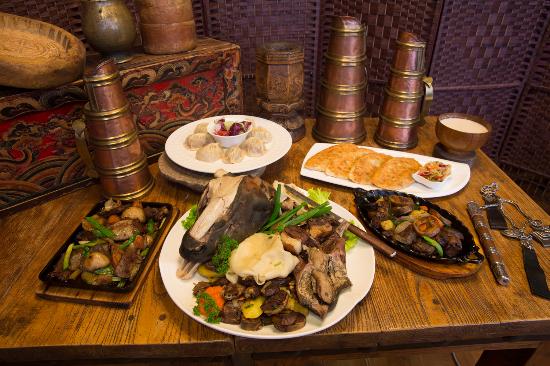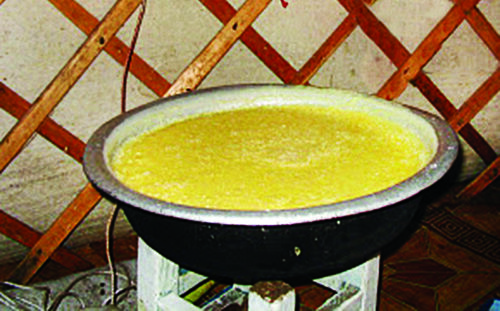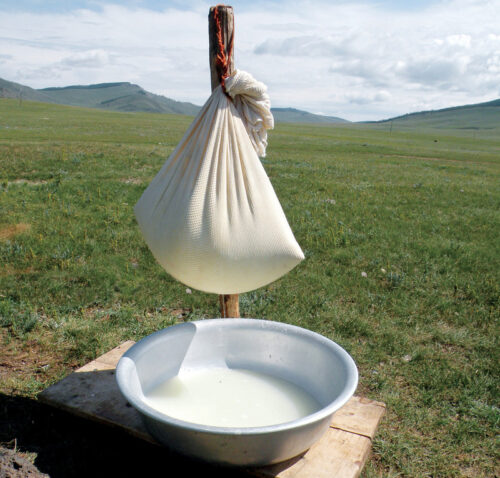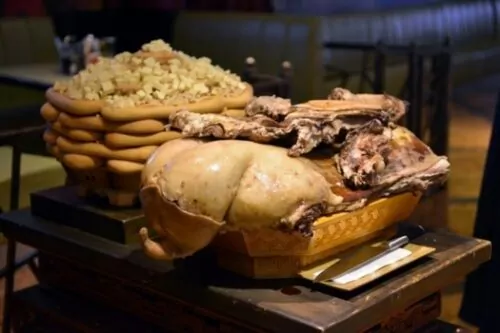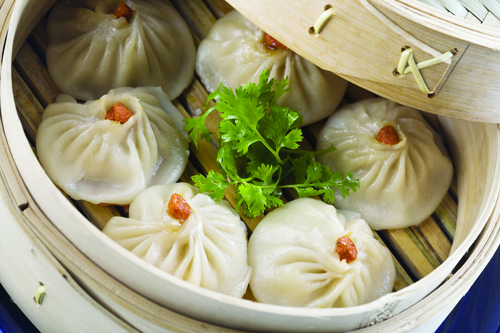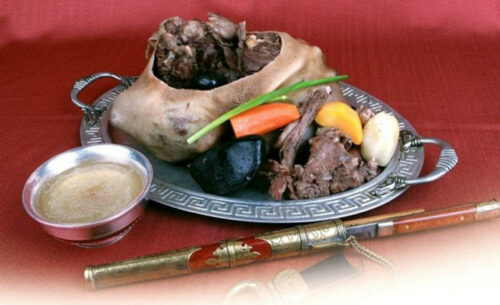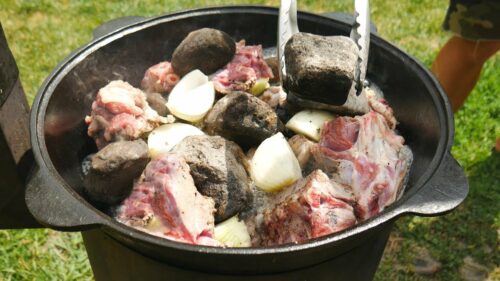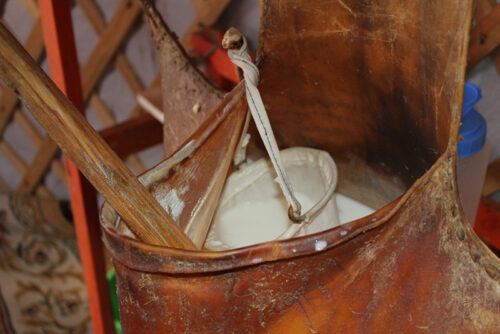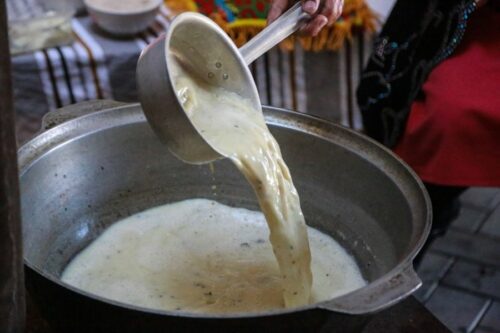Mongolian food is adjusted to the condition of the way of life. It can be divided into milk products, meat or meat products, and vegetable or green products. Mongolians produced over 3,000 types of food and beverages. Let’s take samples.
Milk Slim
This is a type of dairy product. It doesn’t need much skill. It is popular among Mongolians. This tasty nourishing Mongolian food is rich in calories. Mongolians pour the milk of a ewe, nanny-goat, cow, or yak into a cast iron pot and boil it on a cow-dung fire. We then ladle the scalding milk into the cast-iron pot in haste until frothiness. The milk froth rises. Then we cool the scalding milk gradually. The milk froth is coated over the cooled milk, which sits overnight. The coating solidifies the thickness or thinness of the coating, which depends upon milk’s creaminess. Then we separate the milk coating or milk skim from the pot and skim the coating and fold it in a half moon shape, it is called öröm (milk skim) on the wooden slab. We consume it as fresh or dry in summer or consume it in winter. We also freeze it. We produce ghee from milk skim by rendering it and make diverse food by mixing the ghee with agriophyllum, Gobi-rhubarb, sphallerocarpus gracilis, cynomorium and alpine bistort. We also mix the ghee with the barley flour, millet and rice. Also the milk skim is mixed with cherry berries and other berries and boiled curds of ewe milk. There are varieties of dairy products such as nuhash (mash), zagsaamal (jelly), zuurmag (paste) and khailmag (rendered cream).
Boiled Curds
Mongols milk cow, ewe, or nanny goat and boil the milk gently. Then they curdle the boiled milk. Curdled milk releases whey. Then it is boiled in the whey until the whey is absorbed away. Mongolsscatter the boiled curdles on the rack to dry and store them for winter use. They also mix the boiled curds with cream or milk skim and eat it. The boiled curds are a combination of all the good qualities of dairy products. They are nourishing food. Only Mongolians make these kinds of products from milk. The boiled curds are good treatments for chronic troubles of gall and liver.
Oblong Fritter
Mongolian people ferment clotted milk from cow, ewe, and nanny goat and distilled milk vodka. The cheese curds are separated from the whey in a gauze sack. The separated cheese curds are called aarts. These cheese curds are squeezed in squares and sliced into oblong fritters by wire and dried out on the rack. These are called süün khuruud (oblong fritters), and they can be kept for a long time. These are dainties not only for young people, but also for old people by their taste and nourishment.
Lamb Meal, Saddle of Mutton
Mongolians often make meals by boiling the limbs of large or small creatures which are then combined with fat. Plan Carpini, a thirteenth-century emissary from the West, attended the celebrations associated with Güyüg’s accession to the throne and noted that when the Mongolian invited him to the pavilion, they treated him with salt-less dried meat with pickled onion. This is evidence that Mongolians dried meat without salt. Instead, they used separate pickled onions. From ancient times the Mongolians made meals by boiling dismembered limbs or pieces of mutton and treating their honorary guests or visitors at feasts or weddings. Such Mongolian meals are divided into those in which the whole carcass is prepared. We take off the internal organs and pluck the hair of sheep or goat carcasses. Then we stew the whole carcass, cover it with the ghee, and offer it to the feast. Another type of meal consists of pieces of mutton, goat, and seared shanks. It is possible to add some limbs to the above. This is offered at the ceremonies surrounding a new ger warming, wedding, lunar month holiday, and commemoration of the elder’s birthday. Honorary meals consist of a head, tail fat, shoulder and four long ribs, shin bones, and rectum. These are used for the great feast. Other types of meals consist of a shoulder and four long ribs.
Shoulder and Four Long Ribs
This is boiled shoulder and four long ribs. This is considered to be sacred Mongolian food, It is mentioned in the historical resources that we offered this Mongolian Cuisine to the French missionary Rubric in the thirteenth century.
Shin-Bone Preference
The shinbone is one of the preferable limbs for the Mongolians. This is a very ancient custom. If you eat to the dullness, you can be a dullard. This is a famous saying. Mongolians prefer the normal fill of a child’s tummy. Zanabazar, the first grand lama of Mongolia, used to eat only one shin-bone a day. Mongolians believe that if a mother eats a shin bone after her delivery of the baby, she can get strength easily. That is why mothers eat shin-bones muscles and drink its stock; Mongols wash the newborn babies with its stock. One should never break a shinbone. But if a baby’s ears ache, we boil the marrow of a shinbone and drop it into the baby’s ears. The ailing of ears stops. This is traditional. Except for these, we let married couples hold a shinbone and stand up them toward the rising sun and utter:
Homage to the rising sun
Homage to the shinbone
Homage to the solemn bond of our four parents
We offer meat including the shinbone to the altar.
There are many things concerning shin bone in Mongolia.
Steamed Dumpling Buuz
Buuz is a delicate food together with khuushuur (meat in a fried pastry) tsoomoi and byanz. They are evolved from China through centuries and it’s not actual Mongolian Food from the historical point of view. The filling of buuz consists of minced meat with fat seasoned with salt, onions, garlic, allium mongolicum and chives. We cook the dumplings in hot steam.
Sausage of Colon
There are many traditional sausages in Mongolia, including tsagaan shavai or sausage of colon. This is made from seasoned meat and blood and stuffed in a tube of colon (gut). But tsagaan shavai is a sausage made of the clotted blood of a horse or ox mixed with flour and salt seasoned with onion and garlic, stuffed in the colon of a horse or ox. It is boiled in salty water. If you do not over-boil it, it is a soft and tasty sausage. It is necessary to slice and eat the sausage when it is lukewarm.
Sort of Flour Gruel
Bantan is meat broth with very few flour pellets. This bantan is called khurgan bantan (lamb gruel) khonin bantan (sheep gruel) and ükher bantan (cow gruel). The meat of bantan is powdered or chipped. The flour of bantan is formed into tiny pellets. Bantan is probably a privileged provision.
Mongolians make it seasoned with onion, allium mongolicum and german garlic. The missionary Roubruck noted down that “Mönkh Khaan was having bantan; it seemed that he had a hang-over when he entered his room”. This means that the Mongolians have had this food from ancient times. It was diverse kinds of flour cakes, before the Lunar New
Snake Shaped Cakes
Year holiday or a wedding. First, we make a coiled snake-shaped cake. It is an old custom. This is the test of flour and its viscosity kneading and consistency and of rendered tallow in which cakes are boiled. It also expresses its meaning to subdue evil spirits which might enter the flour.
Patterned Cakes
The patterned cake is one of the national and traditional cakes. This cake is made of good wheat flour mixed with milk, cream, ghee, brown or white sugar, and nutmeg. We make the dough and knead it until it has good viscosity and consistency. Then we roll the dough into a flat floor slab and cut it into oblong pieces; we then press this oblong piece upon the patterned mold. Then these cakes are boiled gently in the classified ghee on the fire of the chips of the cow. The first cake mold with a swastika pattern was created by Zanabazar, the first grand lama of Mongolia. This mold is kept at the Gandan monastery which is used by the monks of Gandan monastery for making a few pieces of flour cakes every year. There is a saying: There is no cake other than samnaa (this is a cake that is boiled). There is no sign of honour than sambai (a gauzy piece of the sacred scarf)
Most Famous Mongolian Food Boodog (Sweal)
Boodog is a delicacy in Mongolia. We treat our guests with it. In order to make boodog, a goat is choked without cutting the pit of the stomach of a goat. All the bones and entrails of the dead goat are removed through the neck skin. Then the seasoned meat is stuffed through the neck into the boneless skin. In such a manner, the hot roundish stones and seasoned meat are stuffed alternatively. The seasoned meat consists of onion, allium mongolicum and pepper. Then a bit of water is added to the boneless skin. Then we tie the neck of the boneless skin with the rope of horse’s hair up tightly and place the boneless skin on hot cow dung, turning it in various directions. Those hot roundish stones roast the meat and its skin. We place it on the hot embers and wash it with water. During these periods we take vapors from the neck of the boneless skin. The taste of this meat is delicious; its stock is good for those suffering from mental fatigue. It is good for your health if you roll the warm stone on your finger’s balls.
Khorkhog (Meat Cooked in the Rumen of Sheep)
Khorkhog is one of the best Mongolian Food. This is also a delicacy. Meat is cooked in the rumen of a sheep or goat. The animal’s rumen was disembodied and cleaned. We pour a little water into the cleaned interior and stuff the boneless meat with salt, onion, red pepper, and allium mongolicum. Also, hot stones are stuffed into the boneless meat seasoned with the condiment. The mouth is bound with the cord of hair tightly. Then we place the meat with hot stones on a soft fire of cow dung or on hot embers, which cook the meat. Handling the warm stones after the meal can help to remove your fatigue just like sweal, and its stock (broth) can be drunk for one’s health.
Airag [Mere’s Fermented Milk)
Mongolians start tethering foals and colts on the tiger day of summer. We stop tethering foals and colts on the dog day in autumn. There is a feast for fermenting mare’s milk within three days after tethering foals and colts. There is also a feast for when we stop tethering foals and colts in autumn. The mare’s milk is fermented by churning. This fermented mare’s milk is called airag. The airag emits a delicious smell and its taste can make your mouth water. Every Mongolian loves to drink airag. Both males and females, including children, can drink airag by the bowls, from morning to evening. A bowl for airag holds 1 to 1.5 liters of liquid. In order to make airag, we use the airag skin of the previous year. We hang the soaked airag skin from the base of the ger roof and pour milked milk of mare into the hung skin and ferment the milk with the dried yeast of the previous airag. Then we churn the milk on the skin many times. The churning accelerates the fermentation of milk. The liquid can be churned 2,000-4,000 times. If you churn many times, you can make a good blend of fermentation. Airag plays the role of quenching one’s thirst, satisfying one’s hunger, and treating one’s illnesses because of its calories and nourishment. It has essential bioactive constituents and improves their metabolism. The airag treatment was and is famous for curing chronic illnesses, heart and lung troubles, stomach illnesses, rheumatism, back trouble, scurvy, and dropsy.
Mongol Tea (Suutei Tsai)
Mongolians make tea in various ways. We boil the water for tea and add powdered tea to the boiling water and keep it on the soft fire for two minutes. Then we blend the boiling tea with milk and salt. We ladle up and pour back the blended tea in a flurry. We call tea five dainties. They are water, salt, milk, ghee, and tea. We melt ghee or fat of sheep’s tail and add millet in the cast-iron pot and fry them. Then we pour hot plain tea without dregs, blend it with milk, put the lid on the pot, and keep it for a while. Then we season the boiling with salt and soda. Then we pour it into a kettle. This is called hiitstei tsai or tea with various mixtures. This is thicker and oily tea. It can remove one’s fatigue and satisfy one’s hunger. Mongolian tea is called as, üisen tsai (tea in corky tub), bortstoi tsai (tea with pemmican), torguud tea, tea with ravioli, tea with nettle, and so on. We have many traditions to make tea. Let’s take an example.
Churned Tea
We brew up tea blended with milk, salt, soda, ghee, and barley flour and pour it into a wooden churn and churn it 60-70 times. In this process, there is a good blend of ingredients. But it cools. So we pour and boil the blended tea into the hot pot. We pour it into a kettle, warm it, and drink it. This tea is tasty and nourishing. This tea is good for health. The tea made with wild rose is good for curing scurvy. The tea with wood bark is good for one’s heart. The tea blended with the powdered liver of wild sheep is good for the human liver.

